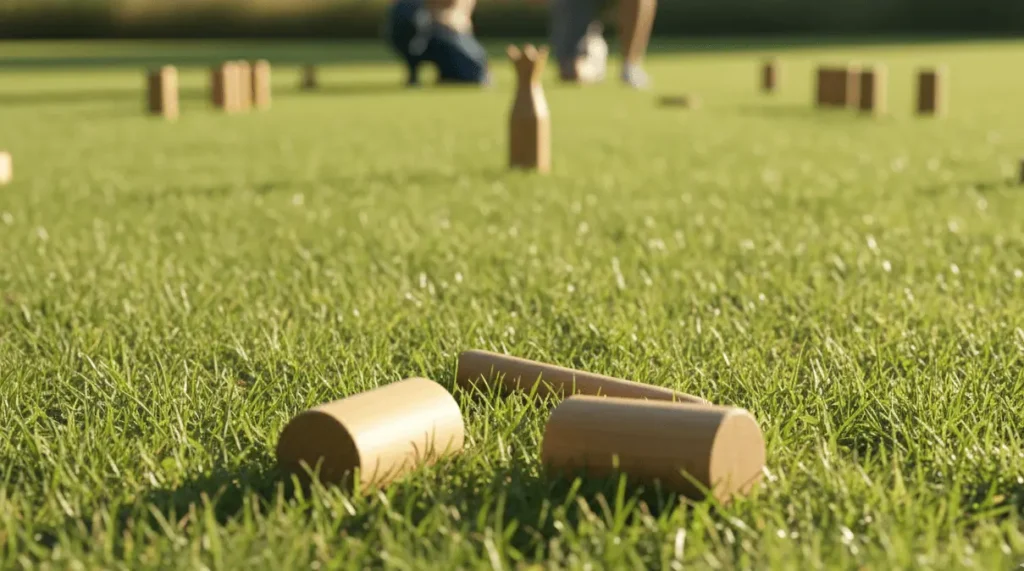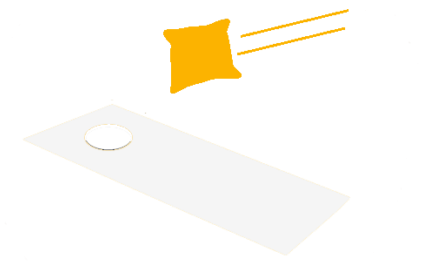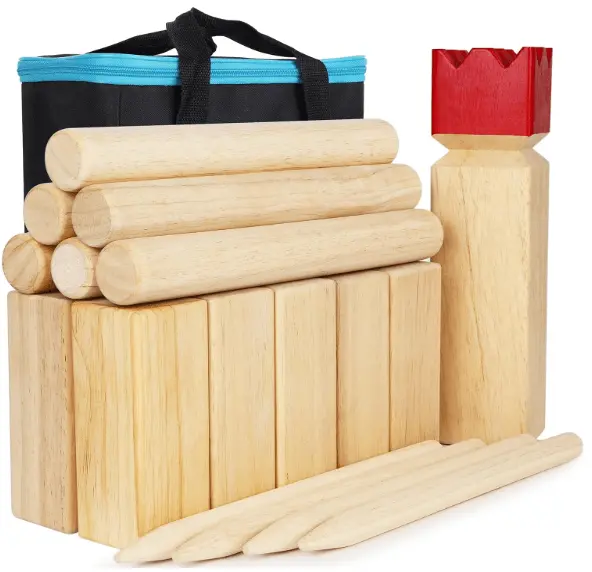How to Play Kubb with Simple Rules and Setup
You’ve seen people tossing wooden blocks at a backyard party. They’re playing Kubb. This Swedish lawn game combines strategy, accuracy, and a little luck. You knock down wooden blocks called kubbs with throwing sticks called batons.
The game goes back centuries. Some say Vikings played it. Whether that’s true or not, Kubb has exploded in popularity across backyards, beaches, and tournaments worldwide.
Let me show you how to play.
What You Need for Kubb
A complete Kubb set includes specific wooden pieces.
You get one king kubb. This tall piece stands 9 to 12 inches high and sits in the center of the playing field. Think of it as the prize. You cannot knock it down until the end.
You get ten regular kubbs. These wooden blocks stand about 6 inches tall. Five kubbs go on each team’s baseline at the start.
You get six batons. These are your throwing sticks. They’re round, about 12 inches long and roughly 1.75 inches thick. You throw these at the kubbs.
You get four corner stakes and two center stakes. These mark your playing field boundaries.
Most sets use hardwood like birch or pine. Tournament quality sets cost more but last longer. Cheap sets work fine for casual play.
This Kubb set gives you all the pieces and stakes you need. You can start a game immediately.
Setting Up the Kubb Field
Kubb needs a rectangular playing area. The official size is 16 feet wide by 26 feet long. Some people use metric and set it up as 5 meters by 8 meters.
You can play on grass, sand, dirt, or even packed snow. Grass works best because kubbs stand up easier.
Place your four corner stakes first. Measure carefully to make a proper rectangle. Put one center stake in the middle of each long side. These divide the field into two halves.
Stand the king in the exact center of the field.
Line up five kubbs along each short edge. These are your baselines. Space the kubbs evenly. Each kubb should be about 3 feet from the next one.
Your field is ready.
Teams and Starting the Game
Kubb works with two teams. Each team can have one to six players. Most games feature two to four players per side.
Decide who goes first with a distance throw. One player from each team throws a baton toward the king from their baseline. Whoever gets closest without touching the king wins. Their team throws first.
If you hit the king during this opening throw, the other team automatically wins the toss and chooses whether to go first or pick their side.
How to Throw Batons
You must throw batons underhand. Hold the baton with one hand. Your throwing motion should make the baton rotate end over end vertically.
Some players throw without rotation. This works too, but the baton must travel straight with zero horizontal spin. Most beginners find vertical rotation easier to control.
Keep both feet behind your throwing line. You cannot step over the line during or after your throw. Your momentum cannot carry you forward.
The baton must stay within 45 degrees of vertical throughout its flight. This keeps the game fair and safe.

Playing a Round of Kubb
Game play follows a specific pattern each round.
Phase One: Throwing Batons at Baseline Kubbs
The first team throws all six batons at their opponent’s baseline kubbs. Players take turns throwing. You want to knock down as many kubbs as possible.
You throw from behind your baseline. Stand anywhere along it as long as both feet stay behind the line and between the sidelines.
Knocked down kubbs stay where they fall until all six batons are thrown.
Phase Two: Throwing Kubbs Into Play
The defending team now becomes the attacking team. They gather all kubbs that were knocked down.
They throw these kubbs onto the opponent’s half of the field. These become field kubbs. You throw kubbs underhand too, but they don’t need to rotate.
The kubb must land completely inside the opponent’s half. If it lands outside the boundary, you get one retry. If your second throw also goes out of bounds, your opponent places that kubb anywhere they want on their half. The only rule is it must be at least one baton length away from the king and the corner stakes.
This punishment kubb rule adds strategy. Missing your throws gives your opponent a huge advantage.
Phase Three: Raising Field Kubbs
The team that threw batons in phase one now raises all field kubbs where they landed. You can position them in any direction, but they must stand exactly where they came to rest.
If two or more kubbs touch each other after being thrown, some groups play the tower rule. You stack touching kubbs on top of each other. This makes an easier target but isn’t required in official rules.
Phase Four: Attacking Field Kubbs First
Now the second team throws their six batons. But they must knock down all field kubbs on their opponent’s side before they can attack baseline kubbs.
This is crucial. If you knock down a baseline kubb before clearing all field kubbs, you must stand that baseline kubb back up. It doesn’t count.
If you clear all field kubbs and have batons remaining, you attack the baseline kubbs with whatever throws you have left.
The Advantage Line Rule
If your opponent fails to knock down all the field kubbs on your side during their turn, you get an advantage. You move your throwing line forward to the field kubb closest to the center line.
You throw all your batons from this advanced position. This makes hitting baseline kubbs much easier.
The advantage line only applies to throwing batons at kubbs. When throwing knocked down kubbs back into play, you always throw from your original baseline. When attacking the king, you always throw from your original baseline too.
Winning the Game
You must clear all field kubbs and all baseline kubbs first. Once you accomplish this and still have batons remaining in that same turn, you may throw at the king.
All king attacks happen from your original baseline, even if you had an advantage line earlier.
Successfully knock down the king and you win.
The Instant Loss Rule
If your baton hits the king before you’ve cleared all opponent kubbs, your team loses right then. Game over.
If a thrown kubb accidentally knocks over the king while being tossed into play, the team that threw it loses.
This rule keeps players careful. Wild throws can cost you the game.

If you want to learn about backyard games, check out my complete guide regarding cornhole and washer toss game.
Kubb Dimensions and Tournament Standards
Tournament kubb follows specific measurements.
Recreational sets vary in size. Smaller sets work fine for kids or beginners. Many store bought sets use smaller pieces than tournament standards.
If you’re serious about the game, invest in tournament size pieces. They play better and last longer.
Strategy Tips for Better Kubb Play
Want to improve your game? Try these tactics.
- Knock down kubbs near the edges first. This gives you more options when throwing kubbs back. Center kubbs are harder to avoid when raising field kubbs.
- Throw kubbs close together. When you’re tossing knocked down kubbs into your opponent’s field, try to cluster them. Grouped kubbs are easier to hit multiple times with one baton.
- Use the punishment kubb strategically. If your opponent gets a punishment kubb, place it where it creates problems. Right in front of their baseline kubbs works great.
- Protect your advantage line. If you get an advantage line, use it wisely. Knock down as many baseline kubbs as possible before your opponent can recover.
- Save your best thrower for last. If you need one perfect shot to win, let your most accurate player take it.
- Watch your opponent’s technique. Learn from good throwers. Notice their grip, release point, and follow through.
Common Kubb Variations
Different groups play with different house rules.
Some tournaments use best of three games instead of single elimination. This gives teams more chances and reduces the impact of luck.
The tower rule is popular in casual play. When thrown kubbs land touching each other, stack them. This creates dramatic targets and speeds up games.
Some groups allow only one attempt at the king per turn. Even if you have batons left, your turn ends after one king throw. This extends games.
Kid friendly versions use shorter distances. Place the baselines 15 to 20 feet apart instead of 26 feet. This makes throws easier for younger players.
Kubb Etiquette and Sportsmanship
- Good Kubb play includes respect for opponents.
- Stay behind the sidelines when the other team throws. Give them space and quiet to concentrate.
- Call your own fouls. If you step over the line or throw with too much horizontal rotation, admit it.
- Keep the playing area clear. When not throwing, stand well back from the field.
- Avoid distracting opponents with noise or movement. Let them throw in peace.
- Disputes happen. Discuss them calmly. If you cannot agree, ask a neutral observer to judge. Most Kubb players value fair play over winning at any cost.
Where to Play Kubb
Kubb works in many outdoor settings.
Parks with open grass are ideal. The soft ground holds kubbs upright and cushions batons.
Beaches work great. Pack the sand firm where kubbs stand. Wet sand near the water line is perfect.
Your backyard needs at least 30 by 40 feet of flat space. This gives room for the field plus safe zones around it.
Avoid hard surfaces like concrete or asphalt. Batons and kubbs take damage from repeated impacts. Players also risk injury from bouncing batons.
Check local rules about wooden projectiles in public spaces. Some parks restrict throwing games.
Frequently Asked Questions (FAQs) about Kubb Rules
Get Your Kubb Game Started
Kubb combines physical skill with tactical thinking. Every throw matters. Every decision about where to place kubbs affects the next turn.
The rules seem complex at first. Play a few rounds and everything clicks into place. You’ll develop throwing rhythm. You’ll spot strategic opportunities. You’ll understand why this ancient game still captivates players today.
Gather your friends. Mark your field. Start throwing. Your first Kubb game awaits!

